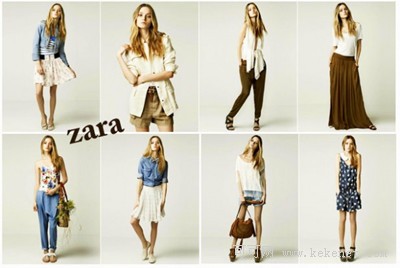One size doesn't fit all
一招鮮,也不能吃遍天

IN GALICIA, not far from the Tower of Hercules which guards the rocky Atlantic coast, sits one of the world's most successful logistics operations. Small items whizz round a two-kilometre carousel and shoot into cardboard boxes. Bigger ones sway by on overhead rails. Lorries come and go like honeybees, taking the goods to far-flung parts of Europe or to airports near Madrid and Zaragoza for freighting to China or Brazil. These are not shipments of medicines or emergency rations, but speed is just as vital: the goods are clothes of the latest fashion, in hot demand everywhere.
加利西亞市毗鄰守望著巖石遍布的大西洋海岸的埃庫萊斯塔。該市的物流運作堪稱世界一流。長達兩千米的旋轉輸送帶轟鳴著輸送著小件物品,并將其拋入硬紙板箱。大件物品搖晃著從頭頂的輸送軌道經過。運貨卡車來來往往,如蜜蜂般將貨物運往歐洲偏遠地區,或者運往馬德里和薩拉加薩附近的機場裝機運往中國或者巴西。這些貨物不是醫藥或者緊急物資,但是速度同樣至關重要:輸送的貨品乃是尖端時尚服裝,在世界各地大受追捧。
Welcome to the world of Zara, purveyor of mass fashion. Amancio Ortega began making clothes in a rented garage in 1963. Now Zara's parent, Inditex, a listed company Mr Ortega still 59% owns, has more than 5,000 stores in 77 countries. It is still growing apace, especially in China, where it will open 80 more stores this year.
歡迎來到Zara世界——大眾時尚的代言人。Amancio Ortega于1963年開始在一間租來的車庫里制作衣服。現在,作為Zara的母公司,已經上市的Inditex公司(Ortega先生仍持有59%的股份)在全球77個國家擁有超過5000家分店。Zara目前仍然飛速發展,尤其在中國。今年Zara計劃在中國再開設80多家分店。
The secret of Zara's success is its speed—four weeks for a new fashion idea to hit the shops—and the feedback that store managers send to head office, to help it fine-tune its ideas. There is also firm control from Spain, the sole logistics hub. Although 34% of Inditex's manufacturing is outsourced to Asia, and 14% to parts of Europe including Turkey, those tend to be the more basic items. The high-fashion stuff, 49% of what it sells, is cut and finished in Spain though some sewing is done elsewhere.
Zara的成功之道在于速度——一個新的時尚設計構思只需四周就可以上架銷售——同時,專賣店的管理人員將回饋發回總部,幫助進一步完善這一構思。同時,在唯一的物流中心西班牙,公司也實施嚴格的控制。盡管Inditex34%的生產已經外包給亞洲國家,14%外包給歐洲部分地區包括土耳其,這些外包的產品都是一些基本款。而占公司總銷售49%的高端時尚產品則在西班牙進行剪裁并制成成衣,部分縫紉工作在其他地區完成。
Few rivals come close. Hennes & Mauritz (H&M) of Sweden is nearest. It is not as fast to market with new styles—months rather than weeks. But where it has caught on, especially in Germany, the Netherlands and Austria, its market penetration is higher. It has distribution centres dotted around Europe. Some 65% of its product is made in lower-cost countries in Asia. That means its cost base is lower than Inditex’s, but it is more vulnerable to disruptions.
Inditex一枝獨秀,罕有匹敵。瑞典的H&M是實力最相近的對手。H&M不似Inditex能夠迅速將新時尚產品推向市場——通常需要數月而不是數周來完成。 但是它在一些地區逐漸趕上了Inditex,尤其是德國,荷蘭和奧地利。在這些地區,它的市場滲透率高于Inditex.H&M的分銷中心遍布歐洲。 而且H&M65%的產品生產在亞洲一些成本更低的國家完成。這使得它的成本來源[1]低于Inditex.但是也更容易遭受干擾。
H&M was late into Asia, which still provides only 3% of revenues. Its January like-for-like sales were up only 1% on January 2010. Inditex, which reports annual results on March 23rd, will probably have done better. A big question, however, is how far it can go on growing from its home base. Now that 15% of its sales are in Asia, does it make sense to run product design and logistics just from Spain? Some clothes it has made in China are shipped to Spain and then back to shops in China. The chief executive, Pablo Isla, sees no need for a second product base: "We're not thinking of replicating the brain in Asia," he says, " though maybe logistics."
H&M進入亞洲較晚,該地區僅占其總收入的3%,今年1月份較2010年1月相比,同比銷售額僅增長1%。而將于3月23日發布年度收入報告Inditex,可能略勝一籌。但是,Inditex能在本土之外有多大作為,值得深思。目前,鑒于其15%的銷售來自亞洲,把產品設計和物流完全依賴于西班牙是否是明智之舉?有些中國生產的服裝被運送回西班牙然后又運回的中國專賣店銷售。公司首席執行官Pablo Isla 認為沒必要再建一個生產基地。他稱,“我們目前不會考慮在亞洲另起爐灶,但可能會建立一個物流中心。
Another question is how long Zara can go on charging such markedly varying prices in different countries. Japanese customers pay about half as much again as west Europeans. Luca Solca of Sanford Bernstein, a research firm, says consumers in China, where Zara also charges more, see high prices as part of a product's appeal. But what will happen as Zara expands its online catalogue? H&M, which is further ahead in this, seems to be maintaining its big regional markups. Mr Solca says the 60% price differences Zara maintains between some countries are unsustainable—but 30% may be quite possible.
另一個疑問在于,目前Zara在不同國家,產品定價大相庭徑,這一做法還能延續多久?同類產品,日本的顧客要比西歐顧客多付50%的價格。伯恩斯坦調研公司Luca Solca稱,在中國,Zara雖然定價也相對較高,但是中國消費者認為高價是產品本身吸引力的元素之一。但是隨著Zara品牌走向在線營銷,會發生怎樣的變化?H&M在差異定價方面走得更遠,似乎它將繼續保持顯著的區域差價。Solca先生稱Zara在不同國家間所所維持的60%的差價似乎難以為繼——但是30%則很有可能。
注釋:
like-for-like sales: 本期銷售額中,由與前期相同的銷售活動實現的銷售量的部分。是在排除本期銷售活動變動帶來的影響后的同比銷售量。











